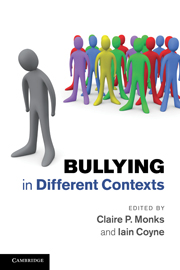Book contents
- Frontmatter
- Contents
- List of figures
- List of tables
- Notes on contributors
- 1 A history of research into bullying
- 2 Peer-victimisation in preschool
- 3 Bullying in schools: thirty years of research
- 4 Peer violence in residential children's homes: a unique experience
- 5 Domestic violence: bullying in the home
- 6 Juvenile dating and violence
- 7 Bullying in prisons: bringing research up to date
- 8 Bullying in the workplace
- 9 Elder abuse and bullying: exploring theoretical and empirical connections
- 10 Cyberbullying
- 11 An overview of bullying and abuse across settings
- Index
- References
5 - Domestic violence: bullying in the home
Published online by Cambridge University Press: 05 June 2012
- Frontmatter
- Contents
- List of figures
- List of tables
- Notes on contributors
- 1 A history of research into bullying
- 2 Peer-victimisation in preschool
- 3 Bullying in schools: thirty years of research
- 4 Peer violence in residential children's homes: a unique experience
- 5 Domestic violence: bullying in the home
- 6 Juvenile dating and violence
- 7 Bullying in prisons: bringing research up to date
- 8 Bullying in the workplace
- 9 Elder abuse and bullying: exploring theoretical and empirical connections
- 10 Cyberbullying
- 11 An overview of bullying and abuse across settings
- Index
- References
Summary
In this chapter we consider domestic violence, including physical and psychological abuse, harm, bodily injury, assault and the infliction of fear between family or household members in the home. We suggest that almost all domestic violence constitutes bullying since it involves the ‘systematic abuse of power’ (Smith and Sharp, 1994, p. 2), which relies on the aggressor's and target's unequal access to power (Farrington, 1993). First, we consider the prevalence of abuse that occurs between adults in intimate relationships; the abuse of children and adolescents by adults; and abuse that occurs between child and adolescent siblings. This is followed by the correlates and impact of each of these types of abuse. We acknowledge that children and adolescents abuse their parents and carers and that this should not be minimised, but because studies of these topics are very sparse we do not consider them here. We then consider theoretical accounts of domestic violence where we feel that they cast light on the phenomenon. Finally, we conclude with implications, as we see them, for policy and professional practice, and with suggestions for further research in the field.
Nature and prevalence of domestic violence
Abuse between adults
The term domestic violence is often used to refer to men as perpetrators of violence in heterosexual relationships. A large proportion of domestic violence between adults consists of intimate partner violence (IPV). The World Health Organization (WHO, 1997) defined IPV in terms of what male intimate partners do to adult and adolescent women.
- Type
- Chapter
- Information
- Bullying in Different Contexts , pp. 87 - 112Publisher: Cambridge University PressPrint publication year: 2011
References
- 4
- Cited by



